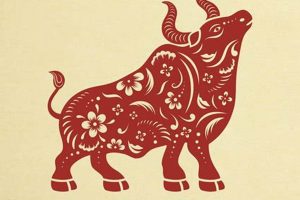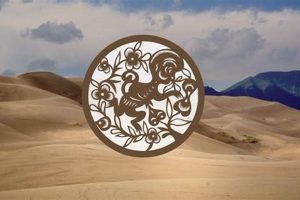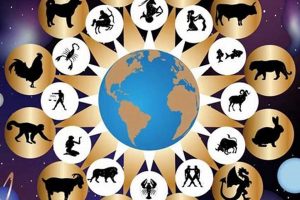The system of animal signs and element cycles used in Chinese tradition to characterize individuals and predict potential outcomes forms a complex tapestry of beliefs. Each animal (Rat, Ox, Tiger, Rabbit, Dragon, Snake, Horse, Goat, Monkey, Rooster, Dog, and Pig) is associated with distinct personality traits, while the five elements (Wood, Fire, Earth, Metal, and Water) add further nuances. For example, a Wood Tiger might be courageous and energetic, while a Water Tiger might be more adaptable and intuitive. This interwoven system provides a framework for understanding individual strengths, weaknesses, and compatibility with others.
Rooted in ancient philosophy and observation of nature, this practice offers a lens through which practitioners seek to understand human behavior and navigate life’s complexities. By understanding these principles, individuals may gain insight into their own tendencies and potential, as well as the dynamics of their relationships. Historically, this system has played a significant role in Chinese culture, influencing aspects of life from personal decisions to social interactions.
Further exploration of individual animal signs, element influences, and the interplay between these factors will provide a richer understanding of this intricate system. This understanding can be applied to enhance self-awareness, improve communication, and navigate interpersonal relationships with greater insight.
Tips for Understanding and Applying Chinese Zodiac Principles
These tips offer practical guidance for incorporating the insights of the Chinese zodiac into daily life. They provide a starting point for self-reflection and improved interpersonal understanding.
Tip 1: Know Your Sign and Element: Accurate identification of both animal sign and element is foundational. Consulting a reliable resource based on one’s birth year is essential for precise determination.
Tip 2: Embrace Nuance: Avoid generalizations. While sign descriptions offer valuable insights, individual experiences and personalities are complex and unique.
Tip 3: Explore Compatibility: Understanding the traditional compatibility and conflict cycles between signs can shed light on interpersonal dynamics, offering potential for improved communication and empathy.
Tip 4: Consider Yearly Influences: Each year is associated with a specific animal and element, influencing the overall energetic landscape. Awareness of these yearly influences can provide context for personal experiences and broader trends.
Tip 5: Use as a Tool for Self-Reflection: The characteristics associated with each sign can be used as prompts for self-analysis, encouraging deeper understanding of personal strengths and weaknesses.
Tip 6: Avoid Deterministic Thinking: The system offers potential insights, not predictions. It should be used as a framework for understanding, not a rigid blueprint for life.
Tip 7: Seek Professional Guidance: For deeper exploration and personalized interpretations, consulting a qualified practitioner is recommended.
By understanding and thoughtfully applying these principles, individuals can gain valuable perspectives on themselves and their interactions with others. This knowledge can contribute to improved self-awareness, enhanced communication, and greater understanding of interpersonal dynamics.
Further exploration of specific applications within different areas of life can deepen understanding and enhance the practical value of these ancient principles.
1. Animal Signs
Animal signs form the foundation of Chinese astrology, providing a framework for understanding personality traits, strengths, weaknesses, and potential life paths. Each individual is assigned an animal sign based on their birth year, creating a 12-year cycle. These signs are integral to interpreting the broader characteristics associated with Chinese astrology.
- Personality Traits:
Each animal embodies specific characteristics. For instance, the Tiger is often associated with courage and dynamism, while the Rabbit symbolizes gentleness and diplomacy. These traits offer insights into an individual’s natural inclinations and behavioral patterns within the context of Chinese astrology.
- Elemental Influences:
Animal signs are further nuanced by the five elements Wood, Fire, Earth, Metal, and Water. Each element imbues the animal sign with additional layers of complexity. A Wood Dragon, for example, might express their inherent Dragon energy differently than a Fire Dragon, demonstrating the interplay between animal and element.
- Compatibility and Relationships:
The interplay between different animal signs influences interpersonal dynamics. Certain signs are considered more compatible than others, offering insights into potential strengths and challenges in relationships. This understanding contributes to a deeper comprehension of social interactions within the framework of Chinese astrology.
- Yearly Predictions and Influences:
The annual cycle of animal signs also plays a role in forecasting potential influences and trends. Each year is associated with a particular animal, and its characteristics are believed to shape the overall energetic landscape. Understanding these yearly influences can provide context for personal experiences within the broader framework of Chinese astrology.
The twelve animal signs, combined with elemental influences and other astrological factors, create a complex and nuanced system for understanding individual characteristics and potential life paths within the broader framework of Chinese astrological traditions. By exploring these interconnected elements, individuals can gain deeper insights into themselves and their place within the intricate tapestry of Chinese astrology.
2. Elemental Influences
Elemental influences are integral to understanding the nuances of Chinese astrological characteristics. The five elementsWood, Fire, Earth, Metal, and Waterinteract dynamically, influencing the expression of each animal sign. This interaction creates a complex interplay of energies that shapes individual personalities and destinies. Each element possesses distinct qualities: Wood represents growth and expansion; Fire embodies passion and energy; Earth signifies stability and groundedness; Metal symbolizes focus and discipline; and Water represents adaptability and intuition. These elemental qualities modify the characteristics associated with each animal sign. For instance, a Wood Rat might be more entrepreneurial and adaptable than a Metal Rat, who might exhibit greater precision and determination. Understanding these elemental nuances provides deeper insights into individual strengths, weaknesses, and potential life paths.
The cycle of elemental interactionscreation, control, and destructionfurther refines these influences. The Wood element fuels Fire, which creates Earth; Earth generates Metal, which produces Water; and Water nourishes Wood, completing the creative cycle. Conversely, Wood depletes Water, Water corrodes Metal, Metal breaks Earth, Earth smothers Fire, and Fire burns Wood in the destructive cycle. These cycles of interaction introduce an additional layer of complexity to the interpretation of Chinese astrological characteristics. For example, while a Water Rabbit might generally be considered gentle and adaptable, the presence of strong Metal influences in their chart could introduce greater resilience and determination, potentially leading to internal conflict or enhanced creativity. Examining these elemental interactions offers practical insights into individual motivations and behaviors.
In summary, elemental influences provide a crucial lens for understanding the complexities of Chinese astrology. By analyzing both the inherent qualities of each element and their dynamic interactions, a more comprehensive and nuanced interpretation of individual characteristics and potential outcomes emerges. This understanding offers valuable insights for self-awareness, personal growth, and navigating interpersonal relationships. Further exploration of the interplay between elements and animal signs within specific contexts, such as career choices or relationship dynamics, can provide practical guidance for navigating life’s complexities. Recognizing the intricate nature of these elemental influences is essential for gaining a deeper understanding of the rich tapestry of Chinese astrology.
3. Yin and Yang Balance
Yin and Yang, fundamental concepts in Chinese philosophy, represent complementary opposites within a unified whole. Yin is often associated with passivity, darkness, femininity, and introspection, while Yang embodies activity, light, masculinity, and outward expression. Within Chinese astrology, this duality manifests in the characteristics attributed to each animal sign and element. For example, the Rabbit, often considered a Yin animal, embodies traits like gentleness and sensitivity, while the Dragon, a Yang animal, exhibits qualities like dynamism and assertiveness. Understanding the Yin and Yang balance within a specific astrological profile provides valuable insights into an individual’s inherent energetic predispositions and potential behavioral patterns. An individual with a predominantly Yin chart might exhibit a preference for contemplation and introspection, while a predominantly Yang chart might suggest a greater inclination towards action and external engagement. This balance, however, is not static; it fluctuates based on the interplay of various astrological factors. For instance, a Yin animal sign paired with a Yang element like Fire can create a dynamic tension, leading to a more assertive expression of typically receptive qualities.
The interplay of Yin and Yang influences not only individual characteristics but also compatibility between individuals. A harmonious balance of Yin and Yang within a relationship is often considered conducive to stability and mutual understanding. For example, a pairing between a predominantly Yin individual and a predominantly Yang individual might create a complementary dynamic where each partner balances the other’s strengths and weaknesses. However, relationships between two individuals with similar Yin or Yang dominance can also thrive, provided there is awareness and acceptance of shared energetic tendencies. Analyzing the Yin and Yang dynamics within interpersonal connections can offer valuable insights into potential areas of harmony or conflict, facilitating greater understanding and communication.
Achieving and maintaining Yin and Yang harmony within oneself is considered essential for overall well-being. Recognizing and addressing imbalances can lead to greater self-awareness and personal growth. Practical applications of this understanding might involve incorporating activities that nurture the deficient aspect. For instance, an individual with excessive Yang energy might benefit from incorporating meditative practices to cultivate Yin, while an individual with excessive Yin energy might find it beneficial to engage in more physically active pursuits to cultivate Yang. Understanding and integrating the principles of Yin and Yang balance within Chinese astrology provides a powerful framework for self-discovery, improved relationships, and a more harmonious approach to life’s complexities.
4. Compatibility Cycles
Compatibility cycles within Chinese astrology provide a framework for understanding interpersonal dynamics based on the interactions between animal signs. These cyclesspecifically the compatibility, clash, and trine relationshipsoffer insights into the potential harmonies and challenges that may arise within various types of relationships, whether romantic, familial, or professional. Compatibility is determined by the position of animal signs within the zodiac cycle. Animals positioned four years apart are considered highly compatible, forming a supportive and harmonious bond. For example, the Rat and the Dragon are often seen as a highly compatible pairing, bringing complementary energies to the relationship. Conversely, signs directly opposite each other on the zodiac wheel form a clash relationship, potentially leading to friction due to conflicting personality traits. The Rat and the Horse exemplify this dynamic, often encountering challenges in finding common ground. Trine relationships, formed between animals four signs apart, represent a balanced and supportive dynamic, like the Rat, Dragon, and Monkey, who often find ease in communication and collaboration. These cycles offer valuable insights into the underlying dynamics at play within interpersonal relationships.
Understanding these compatibility cycles provides practical applications for navigating interpersonal relationships. While not deterministic, these principles offer a lens through which to anticipate potential challenges and leverage strengths within different relationships. For example, recognizing a potential clash dynamic between a Tiger and a Monkey might encourage individuals to approach communication with greater sensitivity and awareness, mitigating potential conflicts. Conversely, understanding the harmonious potential of a trine relationship, like the Ox, Snake, and Rooster, can empower individuals to leverage shared strengths and support each other’s growth. This understanding can lead to more effective communication, stronger bonds, and greater empathy in navigating interpersonal dynamics. In professional settings, this knowledge can be applied to team building and conflict resolution, optimizing collaborative efforts. Similarly, within families, understanding these dynamics can contribute to improved communication and stronger bonds between family members.
In summary, compatibility cycles represent a significant component of Chinese astrology, offering valuable insights into the dynamics of interpersonal relationships. By understanding these cycles, individuals can gain a deeper appreciation for the complexities of human interaction and apply these principles to cultivate more harmonious and fulfilling relationships. While individual experiences and external factors always play a significant role, the framework provided by compatibility cycles offers a starting point for understanding and navigating the intricate web of human connections within the context of Chinese astrological principles.
5. Yearly Predictions
Yearly predictions in Chinese astrology are intrinsically linked to the core characteristics associated with each animal sign and element. These predictions, rather than offering deterministic prophecies, provide a framework for understanding the general energetic influences that may shape the year ahead. Each year is associated with a specific animal and element, and these combined influences are believed to affect various aspects of life, from career prospects to interpersonal relationships. For instance, a year governed by the Yang Wood Tiger might suggest a period of increased activity, dynamism, and opportunity for growth, particularly in areas related to innovation and leadership. However, the specific manifestation of these influences varies depending on an individual’s own astrological chart. A person born under the sign of the Pig, for example, might experience the Tiger year differently than someone born under the sign of the Snake, due to the inherent compatibility and conflict dynamics between these signs. The interplay between the yearly influences and individual characteristics creates a nuanced and personalized interpretation of potential outcomes.
The practical significance of understanding yearly predictions lies in their ability to provide a general framework for navigating the year ahead. By understanding the predominant energies at play, individuals can make more informed decisions, anticipate potential challenges, and capitalize on opportunities for growth. For instance, if a year is predicted to be influenced by the element of Water, which is associated with emotions and intuition, it might be a favorable time for activities related to introspection, creativity, and emotional development. Conversely, a year dominated by the element of Metal might be more conducive to activities requiring focus, discipline, and strategic planning. This understanding empowers individuals to align their actions with the prevailing energies, maximizing potential for positive outcomes. Real-life examples abound, such as individuals using yearly predictions to guide career choices, plan major life events, or navigate relationship dynamics with greater awareness.
In conclusion, yearly predictions represent a dynamic component of Chinese astrology, offering valuable insights into the potential influences shaping the year ahead. These predictions are not fixed prophecies but rather dynamic interpretations of energetic trends, modified by individual astrological characteristics. Understanding these yearly influences empowers individuals to approach the future with greater awareness and make more informed decisions, aligning their actions with the prevailing energies to navigate life’s complexities with greater insight and efficacy. The ongoing interplay between yearly influences and individual characteristics highlights the dynamic and evolving nature of Chinese astrological interpretation.
Frequently Asked Questions about Chinese Astrological Characteristics
This section addresses common inquiries regarding the characteristics associated with Chinese astrology, aiming to clarify potential misconceptions and provide further understanding.
Question 1: How does Chinese astrology differ from Western astrology?
Chinese astrology is based on a lunisolar calendar and utilizes animal signs and elements, while Western astrology primarily uses constellations and planetary positions. These differing frameworks result in distinct interpretive approaches.
Question 2: Is Chinese astrology deterministic?
Chinese astrology offers potential insights into personality traits and potential outcomes, not fixed predictions. Individual choices and external factors significantly influence life paths.
Question 3: Can knowing one’s Chinese zodiac sign accurately predict their future?
Predicting the future is not the purpose. It provides a framework for self-understanding and potential tendencies, not a definitive roadmap. Outcomes remain subject to individual choices and circumstances.
Question 4: How are animal signs determined in Chinese astrology?
Animal signs are determined by the year of birth, following a 12-year cycle. Online resources and consultations with practitioners can provide accurate sign determination.
Question 5: What role do elements play in interpreting Chinese astrological characteristics?
Elements add complexity to animal signs, influencing the expression of inherent traits. Understanding elemental influences provides deeper insights into individual characteristics.
Question 6: How does the concept of Yin and Yang relate to Chinese astrology?
Yin and Yang represent complementary opposites, influencing the balance of energies within each individual’s astrological profile. This balance affects personality, behavior, and compatibility with others.
Exploring these frequently asked questions provides a foundation for a deeper understanding of the nuances and complexities within Chinese astrology. It encourages a balanced and informed perspective on the system’s potential insights.
Further exploration of specific applications and personalized interpretations can enhance understanding and facilitate practical application of these principles.
Conclusion
Chinese astrological characteristics, encompassing animal signs, elemental influences, Yin and Yang principles, compatibility cycles, and yearly predictions, offer a complex and nuanced framework for understanding individual personalities and potential life paths. This system provides a lens through which individuals can gain insights into their strengths, weaknesses, and potential for growth, as well as the dynamics of interpersonal relationships. The exploration of these interconnected components reveals a rich tapestry of symbolic meanings and practical applications, offering valuable perspectives on human behavior and interaction.
The enduring relevance of Chinese astrology lies in its capacity to foster self-awareness and promote a deeper understanding of the human experience. While not a predictive science, the system’s insights can empower individuals to navigate life’s complexities with greater awareness and intentionality. Continued exploration and application of these principles offer the potential for enhanced self-understanding, improved communication, and more harmonious interpersonal relationships. This intricate system invites further study and reflection, offering a timeless framework for navigating the complexities of human existence.







